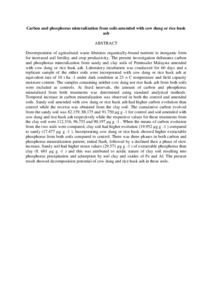Citation
Jamilu, Garba and Abd. Wahid, Samsuri and Ahmad Hamdani, Muhammad Saiful and Othman, Radziah
(2017)
Carbon and phosphorus mineralization from soils amended with cow dung or rice husk ash.
Journal of Environmental and Agricultural Sciences, 10.
84 - 94.
ISSN 2313-8629
Abstract
Decomposition of agricultural waste liberates organically-bound nutrient to inorganic form for increased soil fertility and crop productivity. The present investigation delineates carbon and phosphorus mineralization from sandy and clay soils of Peninsular Malaysia amended with cow dung or rice husk ash. Laboratory incubation was conducted for 60 days and a replicate sample of the either soils were incorporated with cow dung or rice husk ash at equivalent rate of 10 t ha -1 under dark condition at 23 o C temperature and field capacity moisture content. The samples containing neither cow dung nor rice husk ash from both soils were included as controls. At fixed intervals, the amount of carbon and phosphorus mineralized from both treatments was determined using standard analytical methods. Temporal increase in carbon mineralization was observed in both the control and amended soils. Sandy soil amended with cow dung or rice husk ash had higher carbon evolution than control while the reverse was obtained from the clay soil. The cumulative carbon evolved from the sandy soil was 82.159, 88.175 and 91.750 µg g -1 for control and soil amended with cow dung and rice husk ash respectively while the respective values for these treatments from the clay soil were 112.336, 96.755 and 90.197 µg g -1 . When the means of carbon evolution from the two soils were compared, clay soil had higher evolution (19.952 µg g -1 ) compared to sandy (17.477 µg g -1 ). Incorporating cow dung or rice husk showed higher extractable phosphorus from both soils compared to control. There was three phases in both carbon and phosphorus mineralization pattern; initial flush, followed by a declined then a phase of slow increase. Sandy soil had higher mean values (29.571 µg g -1 ) of extractable phosphorus than clay (8. 601 µg g -1 ) and this was attributed to acidic nature of clay soil resulting into phosphorus precipitation and adsorption by soil clay and oxides of Fe and Al. The present result showed decomposition potential of cow dung and rice husk ash in these soils.
Download File
![[img]](http://psasir.upm.edu.my/61043/1.hassmallThumbnailVersion/Carbon%20and%20phosphorus%20mineralization%20from%20soils%20amended%20with%20cow%20dung%20or%20rice%20husk%20ash.pdf)  Preview |
|
Text (Abstract)
Carbon and phosphorus mineralization from soils amended with cow dung or rice husk ash.pdf
Download (6kB)
| Preview
|
|
Additional Metadata
Actions (login required)
 |
View Item |

